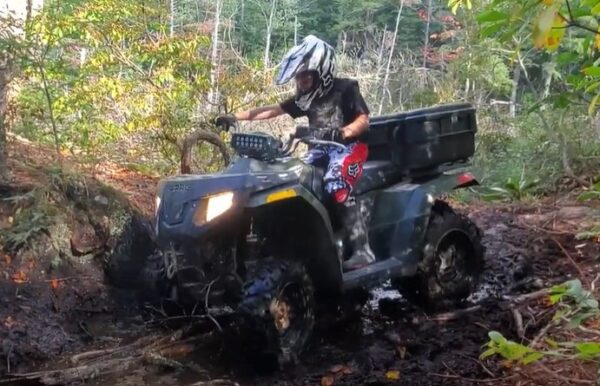The Polaris Hawkeye 300 is a popular ATV produced by the Polaris.
However, despite its popularity and reputation for being reliable, there are still some common problems that can arise with the vehicle.
In this article, I will take an in-depth look at the most common problems of the Polaris Hawkeye 300.
Polaris Hawkeye 300 Problems

1. Carburetor Problem
One of the most common problems of the Polaris Hawkeye 300 is the carburetor problem.
A common symptom of this issue is that the engine will not idle properly while it is cold and will take some time to warm up.
The fuel has likely been sitting in the carburetor for a while, so you should clean it out before attempting any other troubleshooting.
The first step in fixing the carburetor problem should be to shut off the fuel at the tank and then open the drain screw until any excess fuel stops flowing out of the drain hose.
This will allow any build-up of sediment or other materials that could be clogging up the system to be removed.
After doing this, turn the fuel back on and see if there is any noticeable difference in how the engine runs.
If this does not resolve the issue, then you may need to clean out the entire carburetor itself. Remove all parts from within and use fine-grain sandpaper or an ultrasonic cleaner to remove any deposits or residue that may have built up inside over time.
Check for faulty components such as a stuck float needle or seat valve that could be causing fuel to continue flowing into the engine even when it shouldn’t be doing so.
If all else fails, you may need to consider replacing your existing carburetor with a new one altogether. This can be an expensive option but can also provide lasting relief from any issues.
2. Transmission Problem
The transmission problem is the common problem with Polaris Hawkeye 300 that many owners reported.
The most common cause of transmission issues is a lack of maintenance.
Regularly changing the oil, cleaning the air filter, and checking for damage will help keep the ATV running smoothly.
Another common cause of transmission problems is improper use. Towing heavy loads with an ATV can put a strain on its components and lead to premature wear or failure.
To fix this start by visually inspecting all parts of the system – including filters, gaskets, and hoses for damage.
You should also check fluid levels in the transmission to ensure they are at recommended levels.
If these checks reveal nothing out of the ordinary, then you may need to take your vehicle to the dealer.
3. Bogs Under Load
If your Polaris Hawkeye 300 is bogging down when under a load, it could be an issue with the fuel supply.
This can be checked by increasing the engine speed and seeing if the bogging still occurs.
If it does, there may be something wrong with the carburetor or fuel tank/lines, such as a faulty float needle, or clogged fuel filter.
Also, people have reported drilling holes in the airbox of the ATV which can help to reduce this.
It could also be an issue related to angle; when riding uphill or on a side slope, your ATV may struggle due to gravity pulling against it and you might see an increase in bogginess.
You should try running your engine at different angles to fix this and see if that changes anything.
4. White Smoke Problem
Smoking is another common problem with the Polaris Hawkeye 300 ATV.
Mostly white smoke from the exhaust indicates that coolant has entered the engine, and is likely caused by a leaking head gasket.
If this is the case, it’s important to replace it as soon as possible in order to prevent any further damage to the engine.
The smell of the exhaust can also help you to identify the issue. If it is sweet it means that coolant has leaked into the engine.
Checking the spark plugs can also help diagnose if there are any liquid deposits on them, which would indicate coolant entering the engine.
If these issues are identified early on, you should take your ATV to the dealer to fix these issues.
5. Running Rough
This ATV sometimes can have running issues which may cause it to run rough.
This can manifest in many ways, including engine misfires, decreased acceleration capability, limited top speed, increased fuel consumption, and increased emissions.
Other common symptoms are jerking or lurching motions while being driven, as well as difficulty idling or shutting off at stops.
The cause of these running problems can vary greatly depending on the individual ATV’s age and condition.
Common culprits range from worn spark plugs and spark plug wires to clogged air filters and dirty carburetor. If fuel-related issues are suspected, the tank should be checked for any impurities that could be causing damage.
In addition, the fuel pump and injectors should be carefully inspected for proper operation.
Any other mechanical components such as valves and piston rings may also need to be adjusted or replaced if they are not functioning properly.
Is Polaris Hawkeye 300 Worth Buying?
If you want an affordable midsize workhorse with comfort and good handling, then yes—the Polaris Hawkeye 300 is great to buy!
With its modest price tag and robust engine, this machine will be able to handle whatever tasks come your way while delivering an enjoyable ride.
Its compact size allows it to fit into smaller spaces and make tight turns, while its long-travel suspension ensures a smooth ride over rough terrain.
So if you’re looking for a reliable and powerful quad bike with great features at a reasonable price, then the Polaris Hawkeye 300 is worth considering.
Preventative Measures and Solutions
Regular Maintenance
- Scheduled Servicing: Just like any vehicle, the Polaris Hawkeye 300 requires regular check-ups. This helps in early detection of potential issues and ensures that the vehicle performs at its peak.
- Oil Changes: Discuss the recommended frequency and the importance of using the right grade of oil.
- Air Filter Maintenance: The significance of a clean air filter in preventing engine problems and improving fuel efficiency.
- Checking Fluid Levels: Importance of regularly inspecting brake fluid, coolant, and transmission fluid.
- Inspections: Regular visual and hands-on inspections can prevent many problems.
- Belt and Hose Check: Inspecting for cracks, wear, and ensuring they’re adequately tightened.
- Tire Examination: Checking for punctures, proper inflation, and signs of uneven wear.
Aftermarket Upgrades
- Quality over Cost: Emphasize investing in quality aftermarket parts, even if they might be a bit pricier. These can offer better performance and longevity than cheaper alternatives.
- Upgrades for Known Issues: Some recurring problems with Polaris Hawkeye 300 might have been addressed by third-party manufacturers. Offer suggestions for such upgrades.
- Compatibility Checks: Always ensure that any aftermarket component is compatible with the Polaris Hawkeye 300. This not only guarantees optimal performance but also prevents potential damage or issues.
Seeking Expert Assistance
- When to Approach a Professional: While some maintenance and checks can be done at home, highlight situations where it’s crucial to seek expert help, such as electrical issues, deep engine troubles, or transmission problems.
- Choosing the Right Service Provider: Tips on how to select a reliable and experienced technician or service center. Emphasize the importance of reviews, recommendations, and certifications.
- Routine Workshops: Some dealerships or ATV enthusiasts might organize routine workshops or training sessions. Attending these can provide hands-on knowledge and practical tips directly from the experts.
What Users Say About Polaris Hawkeye 300?
The users of this ATV praise its performance, reliability, and affordability. Many users appreciate how lightweight and easy to use it is compared to other ATV models.
Some have noted that the brakes could be stronger, however, most agree that the vehicle’s power and agility make up for this minor issue.
Some owners also report being very pleased with the service they received from their local Polaris dealership.
These are the few reviews of owners who used this ATV.
“I have an 07 with my daughters that ride it. it is a great little machine it amazes people where it will actually go. we ride in a lot of severe conditions & never had any frame problems.it is not real snappy but is like a little mountain goat just keeps going.”
“Goes pretty much everywhere with good tires, outperforms similar quads of similar size. The only downside for me is the Automatic gearbox. Make sure you put all the plugs back in, doesn’t work well in deep water without them (keep slipping, once it’s on land for a minute or two it’s fine.) Very nice suspension, very nice to ride. Bigger and better tires will help a lot.”
Conclusion
The Polaris Hawkeye 300 is a reliable ATV, but as with any machine, it may experience problems.
The good news is that many of the common problems associated with this vehicle are easy to fix and don’t require expensive repairs or replacements.
These are the common problems of Polaris Hawkeye 300.
- Carburetor Problem
- Transmission Problem
- Bogs Under Load
- Runs Rough
- White Smoke Problem
If you have questions or need help resolving an issue, let us know in the comments.
Arctic Cat Alterra 700 Problems
Polaris Sportsman 550 Problems
Polaris Sportsman 600 Problems


